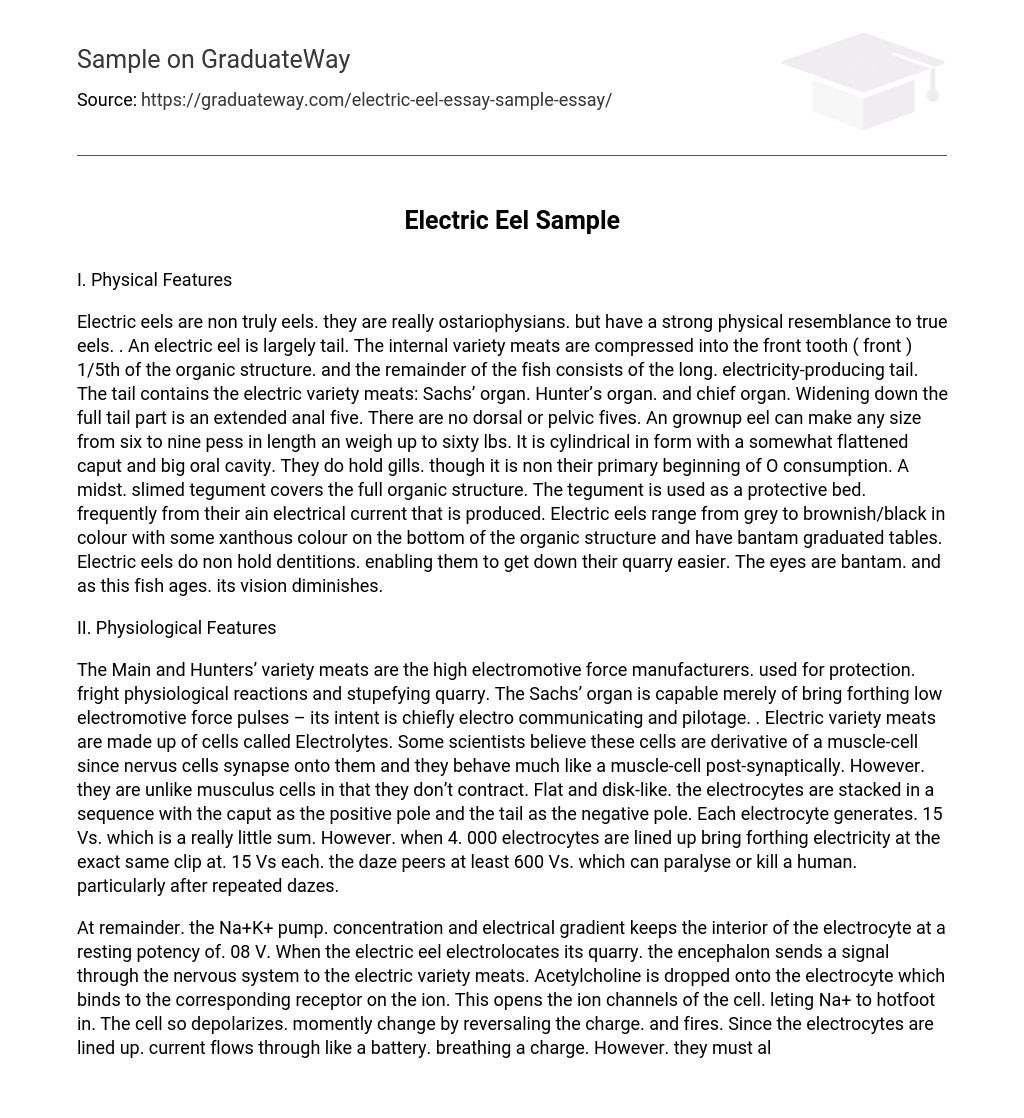Physical Features
Electric eels, despite their physical resemblance to true eels, are actually ostariophysians. They possess a lengthy tail that generates electricity and constitutes the majority of their body. The internal organs are compressed into the front 1/5th of their body. The tail houses three electric organs: Sachs’ organ, Hunter’s organ, and main organ. It also features an elongated anal fin along its entire length but lacks dorsal or pelvic fins. Adult electric eels can grow up to six to nine feet in length and weigh as much as sixty pounds. Their shape is cylindrical with a slightly flattened head consisting of a large mouth and small eyes. Although they have gills for oxygen intake, these are not their primary source of oxygen supply. Their whole body is covered in a thick, slimy skin that serves as protection against their own electrical current. They exhibit colors ranging from grey to brownish/black with some yellow underneath their body. With tiny scales and no teeth, they are more agile at catching prey. As they age, their visual abilities decline.
II. Physiological Features
The Main and Hunters’ variety meats are the high electromotive force manufacturers used for protection, fright physiological reactions, and stupefying quarry. The Sachs’ organ is mainly capable of generating low electromotive force pulses, serving the purpose of electro communication and navigation. Electric variety organs consist of electrolyte cells, which some scientists believe are derived from muscle cells due to their synapse connection with nerve cells and similar behavior to a muscle cell post-synaptically. However, unlike muscle cells, they do not contract. The electrocytes are flat and disk-like and arranged in a sequence with the head as the positive pole and the tail as the negative pole. Each electrocyte produces 15 Vs, which is a small amount. Yet, when 4,000 electrocytes are aligned, simultaneously generating electricity at 0.15 Vs each, the shock reaches at least 600 Vs. Such a shock can paralyze or kill a human, especially after repeated shocks.
At rest, the interior of the electrocyte is maintained at a potential of 0.08 V due to the concentration and electrical gradient of the Na+K+ pump. When the electric eel detects its prey, a signal is sent from the brain through the nervous system to the electric organs. Acetylcholine is then released onto the electrocyte, binding to the corresponding receptor on the ion. This causes the ion channels of the cell to open, allowing Na+ to enter and depolarize the cell. This momentary reversal of charge results in the firing of the cell. As the electrocytes are aligned, current flows through them like a battery, generating a charge. However, it is important that they all discharge simultaneously. To achieve this, the electric eel’s design delays the signals and action potentials at the neural connections. The closer connections have longer and thinner pathways, which slows down the signal and enables all electrocytes to synchronize their discharge.
III. Habitat
The electric eel can be found in the basins of the Amazon River, Orinoco River, and surrounding areas. They inhabit murky, low-oxygenated freshwater rivers and pools. The water in the Amazon river habitat has a low oxygen concentration, which is why the eel frequently surfaces to obtain enough oxygen for respiration. Around 80% of the total oxygen consumed is acquired from the atmosphere, while the remaining 20% is extracted through the gills. CO2 is primarily emitted through the skin (80%), with a small amount also released through the mouth (20%).
The electric eel has successfully adapted and evolved to its preferred environment. It can swim both forward and backward using its undulating anal fin, which improves its awareness of its surroundings. If an electric eel remains in water for more than 20 minutes, it will die. The murky water does not hinder the fish’s vision. In addition to being nocturnal, fully grown electric eels have limited use of their beadlike eyes. Although young eels have the ability to see, adult eels gradually lose their vision due to constant exposure to the electric field they generate. Regardless of whether or not they are electrogenic, all fish produce electric fields. This occurs whenever any muscle is used, so even the contractions of a fish’s heart can be detected by another fish. Eels can accurately locate objects by measuring frequencies and amplitudes in different parts of their bodies, as well as sensing static electricity caused by water flow against the riverbed.
The eel is capable of detecting the conductivity of surrounding objects by utilizing its own electric organ discharge (EOD) and sensing differences in the current. This serves as a means of navigation and obstacle detection. Additionally, the EOD of other electrogenic fish can be utilized for communication.
IV. Miscellaneous
Electric eels have undergone multiple reclassifications, initially being classified as a species in Gymnotus. It was later assigned to its own family, Electrophoridae, but was ultimately demoted to a genus within Gymnotidae, alongside Gymnotus. Acquiring scientific licenses is necessary to obtain electric eels as they can pose great harm to both humans and animals if released into water systems. Their enzymatic research is often focused on the study of Acetylcholinesterase (AchE). Additionally, electric eels are utilized for cancer research. While locals in the Amazon occasionally consume them, their consumption is generally avoided due to the risk of experiencing electrical shocks even up to eight hours after death. Despite lacking commercial value, electric eels have been continuously studied for many years. The scientific community holds significant interest in exploring the electrical capabilities of electric eels, which can prove fatal to horses and deliver a shock that humans can withstand but may not survive multiple times.





